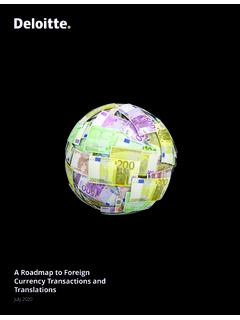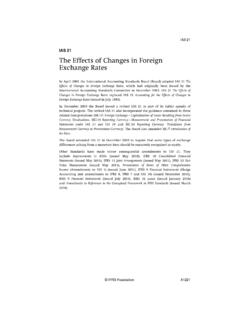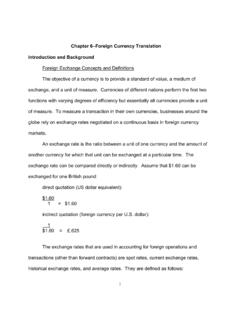Transcription of Foreign Currency Translation under U.S. GAAP-A Simplified ...
1 International Journal of Business and Applied Social Science , , July, 2016. Foreign Currency Translation under GAAP-A Simplified Example Kenneth R. Creech Associate Professor of Accounting Briar Cliff University 3303 Rebecca Street Sioux City, IA 51104. Phone: 712-279-1684. Mail: USA. Abstract: The Translation of Foreign Currency based financial statements is an important issue in today's global business environment. This article will discuss some of the key concepts by the use of a Simplified example. The concepts to be discussed include the selection of a functional Currency , Translation of Foreign Currency based financial statements under Generally Accepted Accounting Principles (GAAP) using the current rate method, other comprehensive income and financial statement disclosure.
2 The step by step example should help professionals through the process of Foreign Currency Translation . Keywords: Foreign Currency Translation , Current Rate Method, Other Comprehensive Income, Statement Disclosure 1. Introduction: Accounting for Currency exchange and Currency Translation comes about when a company has a branch, joint venture or a subsidiary that prepares its' financial statements in a Currency other than the Currency of the parent company. For purposes of consolidated financial statements the Currency must be restated to the Currency used by the parent company in preparing the consolidated financial statements.
3 This paper will discuss the key elements and processes using examples of possible ways that the various elements could be addressed. The key elements and processes include: determination of the functional Currency , identification of appropriate exchange rates to be used and where those exchange rates might be found, use of either the current rate or temporal method for calculating Currency Translation adjustments and finally proper disclosure of the Currency adjustment. These items will be discussed through the use of a hypothetical case study.
4 2. Functional Currency : The first thing that needs to be determined when acquiring or opening a Foreign operation is the functional Currency . under the general guidelines in the Accounting Standards Codification (ASC) Topic 830, Foreign Currency Matters issued by the Financial Accounting Standards Board (FASB), if the operation is basically in control of its' own operations and financing then the Currency would be the Currency of the country where the operation is located. ASC, Topic 830 also states that this is generally a matter of fact and should be based on the Currency where the majority of the cash is received and expended.
5 While this is based on a matter of fact in some cases the facts do not make the decision clear. As an example we will use the hypothetical case of a branch of a based company that is in the The facts are as follows: Page | 1. ISSN: 2469:6501(Online) Center for Promoting Education and Research (CPER) USA, Sales Transacted in dollars (USD) $2,250,000. Transacted in Great British Pounds (GBP) $ 975,000 (USD equivalent). Transacted in Euros $1,500,000 (USD equivalent). Cost of Goods Sold Transacted in USD $1,225,000. Transacted in GBP (USD equivalent) $ 625,000.
6 Transacted in Euros (USD equivalent) $ 500,000. Other Operating Expenses Transacted in GBP (USD equivalent) $1,875,000. Based on the total receipts and expenditures of cash there is no clear answer in these facts as the total transaction value for transactions in both USD and GBP is $3,475,000 while business transacted in Euros accounts for the other $2,000,000. This analysis leads to the conclusion that either the USD or the GBP. could be used as the functional Currency . In this case the company chose to use the GBP as the functional Currency due to the fact that all tax and financial reporting to the government was required to be in GBP (Creech, 2014).
7 3. Income Statement: Translating financial statements for a Foreign entity in preparing for the preparation of consolidated financial statements begins with translating the income Topic 830 requires that all income transactions be translated at the rate that existed at the time the transaction occurred. This is impractical in most cases so ASC Topic 830 allows for the use of an average rate when transactions occur uniformly throughout the year. In our case we will use an average rate based on the average annual rate but businesses that are seasonal or transact business in currencies that fluctuate widely may want to consider Translation on average rates based on quarterly or monthly averages.
8 This is generally accomplished by the use of a weighted average rate (Selling & Sorter, 1983). Many business operations conduct transactions in more than one Currency . In this case the process requires that the transaction that is in a Foreign Currency (not the functional Currency ) first be translated to the functional Currency before the income statement in the functional Currency can be translated into the parent company's Currency for financial reporting. Since Foreign Currency transactions are recorded at one rate and then later restated for a different rate there can be gains or losses associated with these differences in rates.
9 The gains or losses from Foreign Currency transactions are included in current income (Veazey& Kim, 1982).To illustrate the process we will use the entity previously used in the discussion of the determination of the functional Currency . This business is located in the and conducts business in Great British Pounds, Dollars and Euros. The first step in the process will be to convert the Foreign Currency transactions into the functional Currency . During the year there were sales in USD of $ 2,250,000 which were translated at a uniform rate of $ per GBP.
10 This gives us sales of 1,500,000 GBP during the year. We then translate the cost of goods sold that were in USD during the year, the $1,225,000 translates to GBP. We now translate the Foreign Currency transactions conducted in Euros. There were sales of 1,200,000 Euros during the year which yield 960,000 GBP when translated at the recorded rate of Euro per GBP. The cost of goods sold Translation of Euros becomes 320,000 GBP based on the rate. In addition the operation had transactions in the functional Currency as follows: sales, 500,000: cost of goods sold, 416,667; and operating expenses, 1,250,000 all of which are in GBP.








